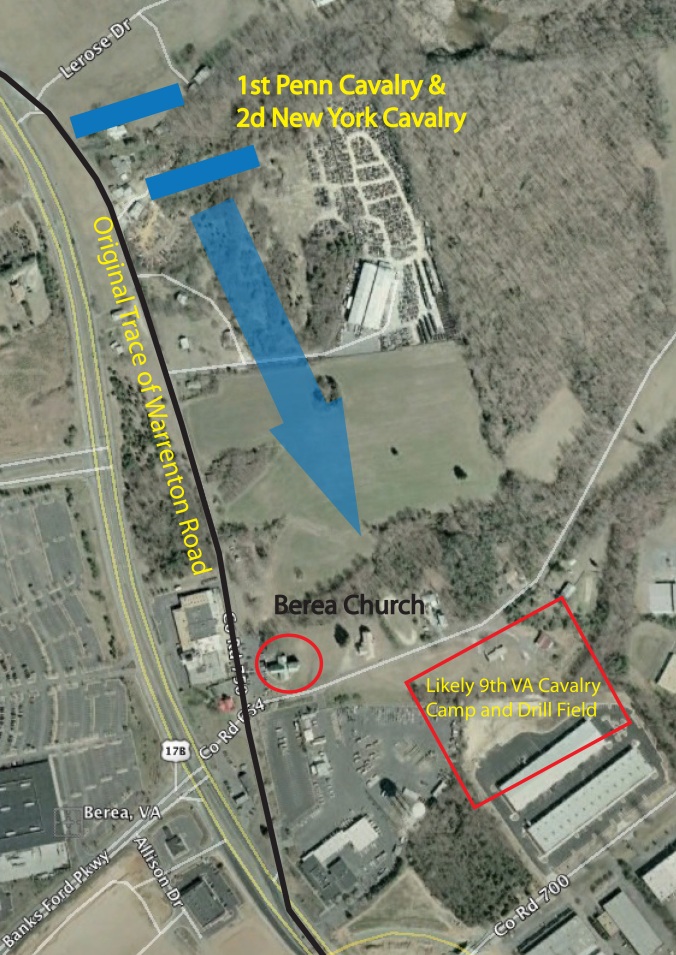From John Hennessy:
One hundred and fifty years ago tomorrow, April 17, the first wave of Union troops began its move toward Fredericksburg. From camps around Warrenton Junction (modern-day Calverton) and Catlett Station on the Orange and Alexandria Railroad, the division commanded by General Rufus King started south. His lead brigade, commanded by General Christopher Columbus Augur, consisted of four New York regiments and the 2d US Sharpshooters. They followed what is today Elk Run Road (Route 806) to the crossroads at Bristersburg, and then south on Bristersburg Road (Route 616) into Stafford County. While these roads would become familiar routes for the Union army as it moved into and out of the Fredericksburg region over the next two years, no Union troops had passed that way prior to April 1862.
By 1862 standards, the landscape these troops passed through was nondescript. It would seem so today as well, except that the area is little changed since the war–the roads still narrow and winding, often closed in by roadside forests. In April 1862, the route’s most notable characteristic was the people the soldiers encountered along the way: slaves. As one New Yorker noted, it was the first and only time during the war the soldiers saw slavery undisturbed. And that status would remain intact for only moments after the arrival of the Union army.
Other troops followed much the same route in the coming days and weeks. One of them remembered,
The road was constantly thronged with contrabands who…were making their way on “double quick,” for the land of peace and freedom. I saw the tears stream down the dark faces of those too old to leave, as those in the prime of life bid them a long adieu, and with hurried step started from the house of bondage. The attachment that exists between the slave and the master, is like the attachment between oil and water… The very institution itself hardens the heart and callouses all feelings of humanity.
At midday on April 17th, the Union columns approached the junction of Bristersburg Road, Hartwood Road (Route 612) and Poplar Road (Route 616). There it likely split, taking both roads south to the Warrenton Road, today’s Route 17. Once on Route 17 (today four lanes rather than 2 and considerably straightened by our friends at VDOT), the column turned left toward Berea Church and Fredericksburg.
 Unaware at Berea was a squadron of the 9th Virginia Cavalry, under W.H.F. Rooney Lee. Lee’s men were drilling in an open field east of the church when they received warning of the Union advance. Lee ordered them to break camp and retreat, but the Yankees were too fast, and the result was a minor embarrassment for the 9th, which scattered toward Fredericksburg. Local boy Eustace Conway recorded the mayhem:
Unaware at Berea was a squadron of the 9th Virginia Cavalry, under W.H.F. Rooney Lee. Lee’s men were drilling in an open field east of the church when they received warning of the Union advance. Lee ordered them to break camp and retreat, but the Yankees were too fast, and the result was a minor embarrassment for the 9th, which scattered toward Fredericksburg. Local boy Eustace Conway recorded the mayhem:
We were ordered at once to camp, to strike tents, gather up our belongings, mount and fall into line and retreat towards Fredericksburg. In the shortest kind of time the enemy were in sight and rapidly advancing, and before the men could all get out of camp they were firing into camp. l was ordered back by my captain to drive the men out of camp This threw me to the rear, the last man. The enemy then charged, and our squadron completely routed and squandered, in no order whatever, every man trying to take care of himself, and in their flight men threw away their blankets, clothing, haversacks, and many of them their arms, and the wagons scattered the cooking utensils, rations and tents along the road.
(You can find a modern photo of Berea Baptist Church here.)
For more than two miles cavalrymen from New York and Pennsylvania would pursue the Confederate horsemen, until Rooney Lee was finally able to bring them to a halt near what is today an Arby’s on Route 17, about a half-mile east of I-95. Immediately, the Confederates started building a barricade across the road. It would become the scene of a chaotic nighttime clash in the early hours of April 18, 1862.
Though the Confederates fled Berea swiftly, they did indeed inflict some damage on the Union horsemen. Among the handful of dead and wounded–the first in the immediate Fredericksburg area–was Lieutenant James Nelson Decker of the 2d New York Cavalry. He, along with several others, would be buried with ceremony at Falmouth’s Union Church several days hence, but that’s a story for our next post….


One of my great-great-grandfathers was in the 9th Va Cav. and was captured in ’62 in the Fredericksburg area. I wonder….
Love the overlay on the modern aerial. Since tourism is the biggest industry in Virginia, it’s a double bang to know that WHF Lee made his stand at the Arby’s. Perhaps the most important thing you can do is to tie this history to the current landscape.
great graphics
Thanks for the post. I had read a pair of letters from Augur’s brigade which mentioned the clash at the barricade but I had never known the context of them before this.
Stu: I will be doing a post on the clash at the barricade very soon…. John H
Pingback: The Battle of Arby’s–A Bloody Barricade on the Road to Falmouth Saves the Bridge at Falmouth « Mysteries and Conundrums
Awesome article & maps!!!